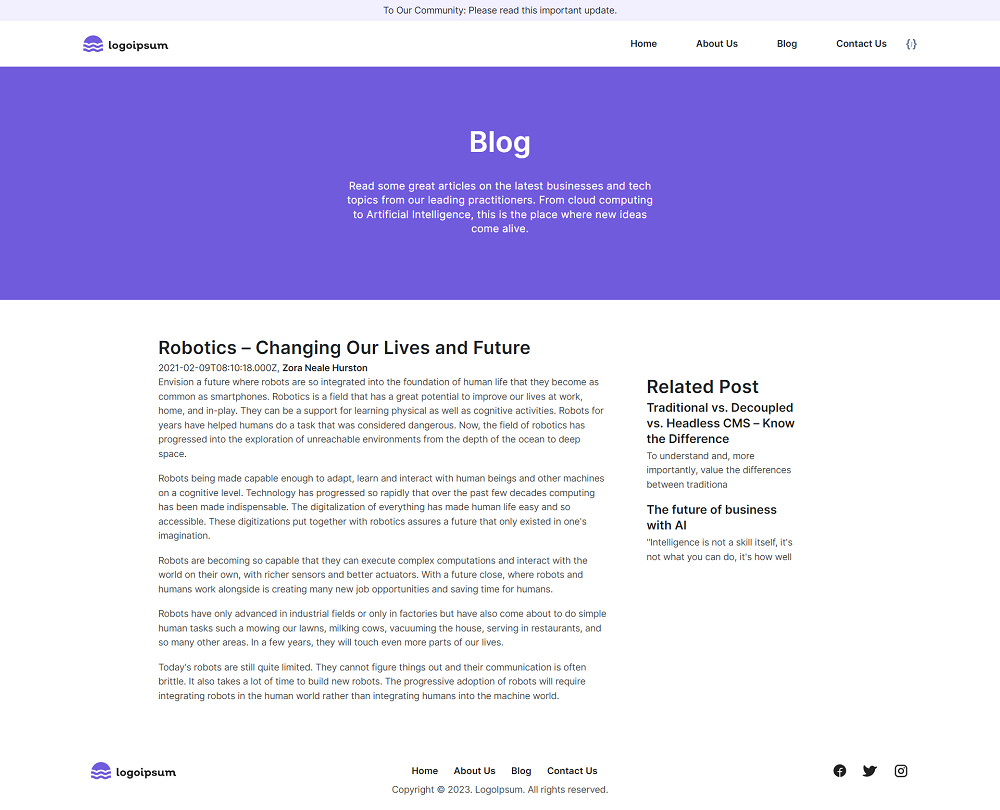Blog Landing Page
The Blog Landing Page is a web page designed to display the blog content to readers. It contains the entire blog post, author details, blog release date and time, and related posts.
The Blog Landing Page is the first page of a blog section on a website where visitors are directed to access blogs. It typically displays a blog and its author details, and a list of related blog posts, which are usually organized in chronological order, with the most recent being at the top. The purpose of the Blog Landing Page is to showcase the full article available on the blog section of a website. It usually includes links to other blog-related content, such as archives, categories, and tags.
The Blog Landing Page Content Model includes fields and structures designed to capture the essential information about the Blog Landing Page.
Prerequisites
- Contentstack account
- Access to the Contentstack Organization/Stack as the Owner/Admin or Stack Developer
Schema for Blog Landing Page Content Model
The Blog Landing Page Content Model contains the Content Types - Blog Landing Page and Author; and Global Fields - SEO and Social Share.
Schema for Blog Landing Page Content Type
- Title: This is a Title field that defines the title of the Blog Landing Page entry. This is a mandatory field and must be unique.
- URL: This is a URL field that adds the redirection URL of the Blog Landing Page. This is a mandatory field and must be unique.
- Author: This is a Reference field that refers to the Author content type.
- Date: This is a Date field that stores the publishing date of the blog.
- Featured Image: This is a File field that allows you to select the image related to the blog and add it to the Blog Landing Page.
- Body: This is a JSON Rich Text Editor field that holds the content of the blog.
- Related Post: This is a Reference field that refers to the Blog Landing Page content type. You can refer to multiple blog articles.
- Is Archived: This is a Boolean field which describes whether the article or blog is archived or not.
- Comments: This is a Group field that holds the following information:
- Leave A Reply: This is a Multi Line Textbox field that stores the reply or request of the user.
- Call To Action: This is a Link field that stores button name as a title and URL for reply/comment submission.
- Social Share: This is a Global field that includes the following components:
- Social Media Share: This is a Group field that holds the following fields:
- Title: This is a Single Line Textbox field that defines the group title for the social media share.
- Icon: This is a File field that allows you to choose the social media icon and add it to the blog. Ideally, the image file for the icon should be less than 100KB in a PNG format.
- URL: This is a Link field that adds a social media name as a title and URL for redirection.
- Social Media Share: This is a Group field that holds the following fields:
- SEO: This is the Global field which includes the following components:
- Meta Title: This is a Single Line Textbox field to add the meta title of your Blog Landing Page. This should be between 120 to 160 characters.
- Meta Description: This is a Multi Line Textbox field to add the meta description of your Blog Landing Page.
- Meta Keywords: This is a Single Line Textbox field to add the meta keywords of your Blog Landing Page.
- Enable Search Indexing: You can enable or disable the search indexing in this Boolean field.
Schema for Author Content Type
- Full Name: This is a Title field that stores the full name of the author. This is a mandatory field and must be unique.
- Picture: This is a File field that allows you to choose the author's photograph. Ideally, the image file for the picture should be less than 100KB in a PNG format.
- Bio: This is a Multi Line Textbox field to add a short description about the author.
Additional Resource: You can import the prebuilt Content Models via the Marketplace (refer to How to Import a Content Model) or via the CMS (refer to Import Prebuilt Content Models to your Stack). Refer the Blog Landing Page Content Modeling documentation to understand how to model the "Blog Landing" page.
After publishing the entry, you can view the Blog Landing Page on your website.



.svg?format=pjpg&auto=webp)


.svg?format=pjpg&auto=webp)
.svg?format=pjpg&auto=webp)
.svg?format=pjpg&auto=webp)
.svg?format=pjpg&auto=webp)




